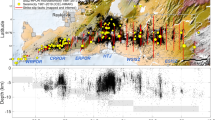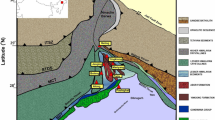Abstract
The 26th April 1986 Dharamsala earthquake (m b 5.5) occurred in the Kangra region of Himachal Himalaya, which lies in the rupture zone of great Kangra earthquake of 1905. This was the first moderate sized earthquake to be recorded at a few sites of the strong ground motion array in the NW Himalaya. The accelerograms of this earthquake have been used to estimate its source parameters, site amplification functions and to estimate the effective shear wave attenuation factor Q β in the frontal region of Himachal Himalaya. A double couple fault plane solution for the earthquake has been obtained based on the spectra of the transverse component of the accelerograms. The estimated values of the source parameters are seismic moment: 2.1×1024 dyne-cm, static stress drop (Δσ): 36 bars, source radius (r): 2.8 km and moment magnitude (M w ): 5.4. The estimated average values of effective shear wave attenuation factor Q β for various sites are in the range of 125 to 300 with an overall spatial average of 239. The influence of local site effects on the observed PGA values have been examined on the basis of site amplification functions.
Similar content being viewed by others
References
Aki, K. and Richards, P.G., 1980, Quantitative Seismology, Vol. I, W.H. Freeman and Company, New York, 535p.
Anderson, J.G. and Hough, S.E., 1984, A model for the shape of the Fourier amplitude spectrum of acceleration at high frequencies, Bull. Seism. Soc. Am. 74, 1969–1993.
Anderson, J.G., 1997, Seismic energy and stress drop parameters for a composite source model, Bull. Seism. Soc. Am. 87, 85–96.
Boore, D.M., 1983, Stochastic simulations of high frequency ground motions based on seismological models of the radiated spectra, Bull. Seism. Soc. Am. 73, 1865–1894.
Boore, D.M., 1986, Short period P- and S-wave radiation from large earthquakes: Implications for spectral scaling relations, Bull. Seism. Soc. Am. 76, 43–64.
Brune, J.N., 1970, Tectonic stress and spectra of shear waves from earthquakes, J. Gepphys. Res. 75, 4997–5009.
Brune, J.N., 1971, Correction, J. Geophys. Res. 76, 5002.
Chandrasekaran, A.R. and Das, J.D., 1992, Strong motion arrays in India and characteristics of recent recorded events, Memoir Geol. Soc. India 23, 81–122.
Dainty, A.M., 1981, A scattering model to explain seismic Q observations in the lithosphere between 1 and 30 Hz, Geophys. Res. Lett. 8, 1126–1128.
De Natale, G., Iannaccone, G., Martini, M. and Zollo, A., 1987, Seismic sources and attenuation properties at the Campi Flegrie Volcanic Area, Pure Appl. Geophys. 125, 883–917.
Dinesh Kumar, Teotia, S.S. and Khattri, K.N., 1997, The representability of attenuation characteristics of strong ground motions observed in 1986 Dharamsala and 1991 Uttarkashi earthquakes by available empirical relations, Current Science 73, 543–548.
Kumar, D. and Khattri, K.N., 2001, Average intrinsic Qs in the crust and uppermost 8 km of mantle in the Ganga plains, Bihar, Current Science 77, 748–749.
Fletcher, J.B., 1995, Source parameters and crustal Q for four earthquakes in South Carolina, Seism. Res. Lett. 66, 44–58.
Gansser, A., 1964, Geology of Himalaya, Interscience, New York, 289p.
Hanks, T.C. and Kanamori, H., 1979, A moment magnitude scale, J. Geophys. Res. 84, 2348–2350.
Hanks, T.C. and McGuire, R.K., 1981, The character of high frequency strong ground motion, Bull. Seism. Soc. Am. 71, 2071–2095.
Hanks, T.C., 1982, fmax, Bull. Seism. Soc. Am. 72(4), 1867–1879.
Haskell, S., 1960, Crustal reflection of plane SH waves, J. Geophys. Res. 65, 4147–4150.
Herrmann, R.B. and Kijko, A., 1983, Modelling some empirical vertical component Lg relations, Bull. Seism. Soc. Am. 73, 157–171.
Kanamori, H. and Anderson, D.L., 1975, Theoretical basis of some empirical relations in Seismology, Bull. Seism. Soc. Am. 65, 1073–1095.
Khattri, K.N. and Tyagi, A.K., 1983, Seismicity patterns in the Himalayan plate boundary and identification of the areas of high seismic potential, Tectonophysics 96, 281–297.
Khattri, K.N., 1987, Great earthquakes, seismicity gaps, and potential for earthquake disaster along the Himalaya plate boundary, Tectonophysics 138, 79–92.
Kjartansson, E., 1979, Constant Q-wave propagation and attenuation, J. Geophys. Res. 84, 4737–4748.
Kumar, S. and Mahajan, A.K., 1991, Dharamsala seismotectonic zone – neotectonics and state of stress in the area, J. Himalayan Geology 2, 53–57.
Masuda, T. and Suzuki, Z., 1982, Objective estimation of source parameters and local Q values by simultaneous inversion method, Phy. Earth Planet. Int. 30, 197–208.
Menke, W., Vadim, L. and Sethi, R., 1995, Seismic attenuation in the crust at the mid-Atlantic plate boundary in south-west Iceland, Geophys. J. Int. 122, 175–182.
Molnar, P., 1990, A review of seismicity and the rates of active underthrusting and deformation at the Himalaya, J. Himalayan Geology 1, 131–154.
Nakata, T., 1989, Active faults of the Himalaya of India and Nepal, Geol. Soc. America, Spec., Paper 232, 243–264.
Ni, J. and Barazangi, M., 1984, Seismotectonics of the Himalayan Collision zone: Geometry of the underthrusting Indian plate beneath the Himalayas, J. Geophys. Res. 89, 1147–1163.
Ólafson, S., Sigbjörnsson, R. and Einarsson, P., 1998, Estimation of source parameters and Q from acceleration recorded in the Vatnafjöll earthquake in south Iceland, Bull. Seism. Soc. Am. 88, 556–563.
Peng, K.-Z., Wu, F.T. and Song, L., 1985, Attenuation characteristics of peak horizontal acceleration in northeast and southwest China, Earthquake Eng. Struct. Dyn. 13, 337–350.
Rovelli, A., Bonamassa, O., Cocco, M., Bona, M.D. and Mazza, S., 1988, Scaling laws ans spectral parameters of the ground motion in active extensional areas in Itlay, Bull. Seism. Soc. Am. 78, 530–560.
Sarkar, I., Hamzehloo, H. and Khattri, K.N., 2003, Estimation of causative fault parameters of the Rudbar earthquake of June 20, 1990 from near field SH-wave data, Tectonophysics 364, 55–70.
Sato, R., 1979, Theoretical basis on relationships between focal parameters and earthquake magnitude, J. Phys. Earth 27, 353–372.
Seeber, L., Armbruster, J. and Quittmeyer, R., 1981, Seismicity and continental subduction in the Himalayan Arc, in: Gupta, H.K. and Delany, F.M. (eds.), Hindu Kush, Himalaya: Geodynamic Evolution. Geodyn. Ser., Am. Geophys. Union, 3, 215–242.
Singh, S.K., Mohanty, W., Bansal, B.K. and Roonwal, G.S., 2002, Ground motion in Delhi from future large/great earthquakes in central seismic gaps of the Himalayan arc, Bull. Seism. Soc. Am. 92, 555–569.
Sriram, V. and Khattri, K.N., 1999, Modelling of strong ground motions from Dharamsala earthquake of 1986 (mb 5.7), Current Science 76, 429–438.
Utsu, T. and Seiki, A., 1954, A relation between the area of aftershock region and the energy of main shock, J. Seism. Soc. Japan 7, 233–240.
Valdiya, K.S., 1981, Tectonics of the central sector of the Himalaya, In: Delani, F.M. & Gupta, H.K. (eds.), Zargos-Hindukush-Himalaya: Geodynamic Evaluation Geodynamic Series 3, American Geophysical Union, 87–110.
Yeats, R.S., Nakata, T., Farah, A., Fort, M., Mirza, M.A., Pandey, M.R. and Stein, R.S., 1992, The Himalayan frontal fault system, Annales Tectonicae, Special issue, supplement to v 6, 85– 98.
Yeats, R.S., Seih, K. and Allen, C.R., 1997, The Geology of Earthquakes, Oxford University Press, 568 p.
Author information
Authors and Affiliations
Corresponding author
Rights and permissions
About this article
Cite this article
Ram, V.S., Kumar, D. & Khattri, K.N. The 1986 Dharamsala earthquake of Himachal Himalaya – estimates of source parameters, average intrinsic attenuation and site amplification functions. J Seismol 9, 473–485 (2005). https://doi.org/10.1007/s10950-005-1418-x
Received:
Accepted:
Issue Date:
DOI: https://doi.org/10.1007/s10950-005-1418-x




